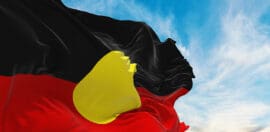Looking beyond the statistics of closing the gap

28 March 2022 at 4:58 pm
Following the release of the 13th annual Close the Gap report, we speak to the CEO of the Lowitja Institute, Professor Janine Mohamed, about the need for governments to embrace genuine partnership with Aboriginal and Torres Strait Islander peoples to close the gap in health outcomes.
While acute rheumatic fever (ARF) is rare in most developed countries, rates among Aboriginal and Torres Strait Islander people are among the highest in the world, especially for those living in rural or remote parts of central and northern Australia.
The illness is caused by an autoimmune response to a group A streptococcus, or Strep A infection, and can lead to rheumatic heart disease (RHD), a serious heart disease that damages one or more of the four small heart valves.
Both diseases are driven by social and environmental determinants of health, including poor quality housing, overcrowding and poverty. They are fully preventable.
In 2018, a new approach to fighting the disease was taken, one that put Aboriginal community members at the centre.
The Champions4Change program supports First Nations people of all ages who are living with RHD and ARF. Entirely designed and run by Aboriginal and Torres Strait Islander peoples and communities with lived experience of ARF and RHD, the group support each other, advocate for ending RHD and design education and awareness programs for those in their own communities.
The program emerged following a review led by Vicki Wade, a senior Noongar woman and RHD Australia director, that identified a clear need for an Aboriginal and Torres Strait Islander specific program that had self determination and culture at its heart.
Wade said in the report that having solutions come from the community meant health information was delivered in a culturally appropriate way that the community understood.
“They have the cultural knowledge and the cultural protocols and lore,” she said.
“Elevating Aboriginal and Torres Strait Islander voices automatically elevates Aboriginal and Torres Strait Islander epistemologies and ontologies. Cultural strength is part of the foundation of the program.”
The story of the program, and Wade’s leadership, is one of several case studies included in this year’s Closing the Gap Report, highlighting the strength of Aboriginal-led solutions.
Time for Australia to catch up
Produced by the Lowitja Institute, this year’s report centres on the work of community-led organisations and services providing health care for Aboriginal and Torres Strait Islander peoples in Australia.
Among its key recommendations are calls for action on gender and climate justice, a national housing framework, and full implementation of the Uluru Statement from the Heart.
Lowitja Institute CEO, Adjunct Professor Janine Mohamed, said that the report showed that community-led work on closing the gap on health outcomes was already happening, but now it needed to be “truly” supported.
“The report is a beautiful and powerful call to action, showcasing Aboriginal and Torres Strait Islander-led brilliance at work, in all sorts of settings, paving the way ahead as we have done as peoples over millennia,” Mohamed said.
“Now it’s time for governments and mainstream services to step up, and step back, if we are to truly close the gap in health outcomes for our peoples.”
In 2020, a new National Agreement on Closing the Gap was unveiled, promising to work in equal partnership with Aboriginal and Torres Strait Islander people, completely resetting the original 2008 targets which saw little progress year on year.
Effective partnerships take time and trust
Mohamed told Pro Bono News that an important part of a strong partnership between government and Aboriginal and Torres Strait Islander peoples was building trust, something that took time and effort.
“It’s about providing dedicated and ring-fenced resources… and honouring Aboriginal and Torres Strait Islander ways of knowing, being and doing,” she said.
“And all of that requires that expansion of knowledge and understanding that historical truth telling could really bring to a relationship.”
She said that holding onto hope was critical, but it was time the rest of Australia listened to the solutions communities were putting forward.
“When you don’t get listened to, it leads to hopelessness, and what you see sometimes in Aboriginal communities is a hopelessness of people that haven’t been listened to,” she said.
“We can’t cherry-pick solutions, all priority reforms have to be fully implemented, fully resourced and be led by Indigenous communities.”
See a full copy of the report here.







